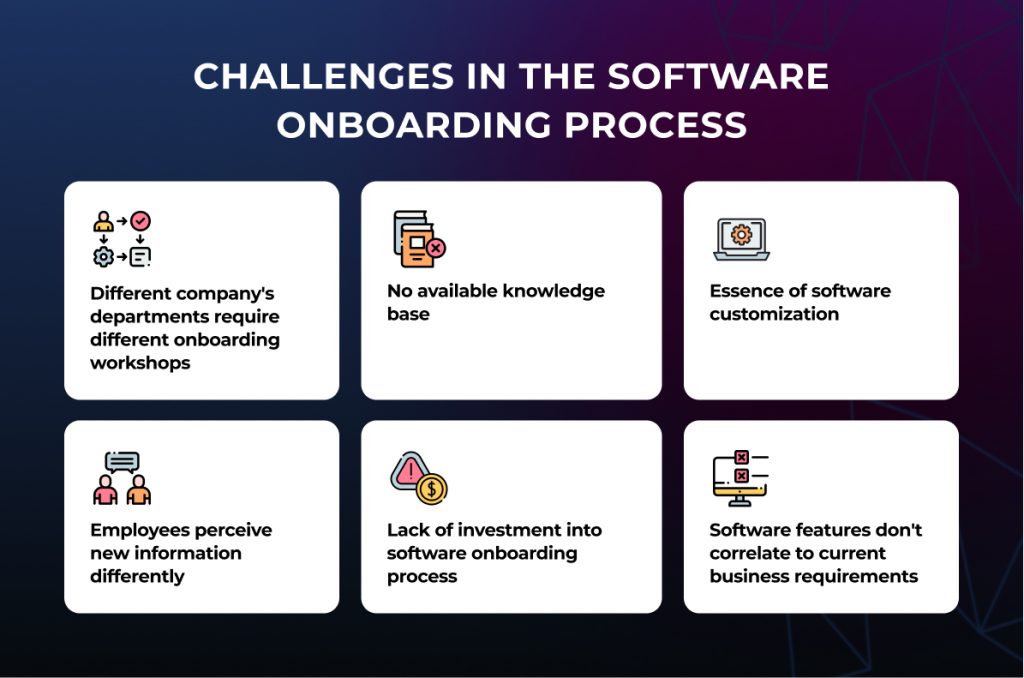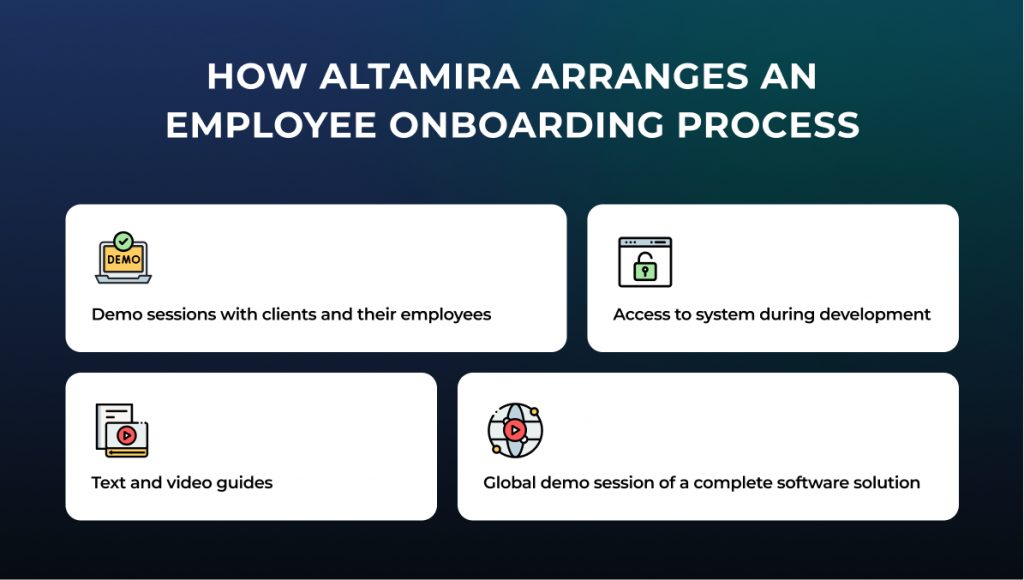These days, businesses of various niches cannot do without software systems that streamline and automates their inner process, boosting the effectiveness of human resources. No matter what software app the company integrates – off-the-shelf or custom one – the onboarding process of employees to use this software effectively can be quite challenging.
In this article, we will take a closer look at the importance of holding an employee onboarding process when installing new software and what approach to follow to make this process quick and effective.
Why is onboarding process to a new software system important?
The majority of businesses who have already gone through the user onboarding to a new software claim that the onboarding step is pivotal in the entire software implementation. The onboarding process requires time, effort, and investment, just like software product development.
Basically, there is no common onboarding technique or approach that suits different businesses and software systems. This process has to be designed according to the demands of your team and the specifics of the software solution you are going to integrate. It grows the understanding and loyalty to new operations within the company of your employees.
Generally, there are two main types of employee onboarding process to use the new software product in their work – self-service and full-service.
Self-service onboarding process entails user onboarding provided by the software supplier in both cases – if you select a ready-made system or develop a custom solution directly for your business. The software vendor has to smoothly integrate the solution with the existing business app within your processes and also train your employees on how to use all privileges of a new solution for their daily tasks. Employees can additionally receive text or video guides on how to use the solution.
Full-service software onboarding engages not only the effort of software providers but also the internal company teams who are tasked with holding full-fledged workshops to train each company department separately and effectively.
The combination of these two onboarding types will provide your company with success. For instance, in Altamira, we deliver our client the service of user onboarding where we explain the value of a new software system for business as well as for each department and employee, and where we show how to use the system options in practice.
We have done this process many times within our company, and we are willing to share this valuable knowledge and skills with our clients who we build custom business software for.
Challenges in the software onboarding process

Overall, employee onboarding is always challenging, and its success ultimately depends on the precise plan of integration. Custom software integration is always easier as the software usually offers such a service – to train your employees during the time they require. But if we talk about ready-made business systems, many issues may arise, and some of them are:
- Commonly, a business software solution includes several parts of functionality where each part is used within different company departments; thus, each department requires separate workshops to learn how to use the part of the solution they require to execute their daily tasks. If the company leaders force the entire team to learn each option for a new solution, the effectiveness of training will decrease, as well as the employee’s motivation.
- The training information has to be provided partially or divided into learning stages with practical workshops to ensure the employees succeeded in the software onboarding process. If the company trainers provide huge amounts of information at one time, probably no one will memorize software onboarding instructions properly.
- Off-the-shelf software solutions provide the options of customization to the business requirements and rules. This training part is as important as the solution functionality; customization streamlines the employee work, so missing this training can be mistakable.
- Surely, the company cannot coffee the individual training sessions for each employee; however, it is vital to consider that people have different levels and abilities to perceive new information, meaning when some require only one workshop, others can still need several training sessions to consolidate the knowledge.
- Lack of investment in the onboarding program of employees to new software can be harmful to their work as well as the work of the entire business; commonly, software partners offer onboarding programs to teach employees how to effectively use a new type of business software system and get all benefits it gives for their work.
- Non-conformity of software functions to current business needs and requirements leads to misunderstanding within your team, when the employees don’t understand the value and needs of the software, the process of perception can last forever.

Have issues with user onboarding?
Contact us so our team could provide a personalized flow for your case
How to onboard employees to a new software effectively?
At this point, we are willing to share practical pieces of advice on how to onboard your employees to use the new software product with maximum use for the execution of their tasks. Surely, each business requires an individual approach and some steps of the user onboarding process may vary depending on the software and business specifics.
We provided the overall tips based on our experience that will come in handy during this complex process.
Ensure your employees understand the benefit
The first thing to start in the onboarding process of your staff to a new software solution is to explain the necessity and benefits of this integration. Gaps in communication with the team and avoiding consulting with them can lead to a failure with software implementation into inner processes.
The company leaders have to be as transparent as possible to show the real value and profits of new software for all company departments. As for leaders, we recommend holding the communication openly and sincerely and being ready to answer all questions truthfully.
This method will fasten the process of acceptance of a new working approach and business software solution overall if each employee will clearly unbeaten the benefits of using this software for his or her particular duties.
Corresonding to ongoing business needs
According to the type of software, your business is going to implement, you need to ensure this software solution is exactly what your company requires at the moment. Foremost, HR managers have to hold surveys among different departments to define their core struggles and complexities with current processes or software systems to consider them in the new software you are going to introduce.
The task of any business software system is to streamline the inner process and operations, thereby simplifying the world of all departments and making employees more productive. The opinion of the team is pivotal to making the process of user onboarding smooth and receiving the maximum profit from using a new business app.
Gradual learning
The employee onboarding process to a new software system has to be gradual and conditionally divided into several steps.
The first vital thing to consider is the diversity of knowledge about technology among your staff, meaning some people are familiar with the software while others have little to do with the existing software app within your company processes.
The most effective strategy in onboarding processes of employees to a new software system is to show them practical knowledge. You have to arrange inner workshops where people with more advanced skills in using this solution can explain and show how to use it for different departments, as the options for different branches are available.
In addition, we recommend creating documents with all guides and explanations for your employee to answer all potential questions that may appear when using new software for their daily tasks.
Training is mandatory for all employees
The training workshops to onboard employees to new software need to be obligatory for all departments if this software solution is related to their job somehow. The training should be divided into separate topics or software functions, as this approach is more effective than present in all software capabilities at once.
In addition, we recommend holding the training during working hours, as probably only a few workers will have the willingness to spend time on weekends or after working days. Each employee has to understand why he or she requires hit software and also be acquainted with its all function and purpose.
Determine the deadlines
We would like to repeat once again that the new software implementation has to be gradual and up to the speed of your team. Don’t set strict deadlines at the very beginning as it will have no efficiency to the process but only stress your employees.
The onboarding process needs to be qualitative, but it doesn’t mean fast. Your staff still has their daily tasks and duties that are more essential to execute in time than onboarding training to compare. You may need even more time than you expected if your business has never used any type of software, which is unlikely these days.
How Altamira arranges an employee onboarding process

Our teams hold a user onboarding to use a new software solution on each project we build during the development process.
As we use the Agile approach in software development, the entire software project is divided into sprints – each sprint is responsible for developing a certain part of the functionality. Therefore, our team creates a clickable prototype (design) after each sprint is completed, so that the engineers, client, and employees could test it, reveal mistakes and imperfections, and also learn how to use it overall.
Thus, the onboarding process is divided into several workshops and the learning process flows gradually, which is more effective than learning the entire system at one time.
The workshops are commonly held for the company leaders (our clients) and team leads of the client company departments. Based on our experience, this training approach is the most effective, as team leaders can teach their employees much quicker and more efficiently than if the entire company will take part in workshops.
However, we had projects where we had the ability to hold the employee onboarding to new software for the whole team, which was not sure of enterprise size.
So, to sum up, the user onboarding process we follow and provide our clients in Altamira, the key steps are:
- Regular live sessions with clients where our teams show how each developed function of the application works, testing for different cases and their work and exploring the logic of the actions users take; in addition, the sessions are recorded and sent to the client after each meeting;
- Providing access to the application during the development stage so that client could test and provide user feedback about the work with the application; a client also can ignite some of his employees to receive additional reviews;
- Preparation of instructions for clients and their employees in text, image, and video formats if such is required;
- Global demo of the complete software system for clients and employees to onboard them on a system, finally;
- Paying much attention to the UX part during the development part so that all actions users will have to take would be intuitive and understandable.
To end up
The process of customer onboarding to use a new software solution comes along with the development flow. The testing of each developed part of functionality allows the developing team to make the software system precisely due to the business requirements of a client, easy to use, and highly functional for the client’s business.
That’s what approach we follow in Altamira and based on our durable experience, this approach in development proved to be the most efficient. No matter what kinds of software systems we build and what level of complexity, the employee onboarding program to new software can still be seamless and simple if done gradually.






